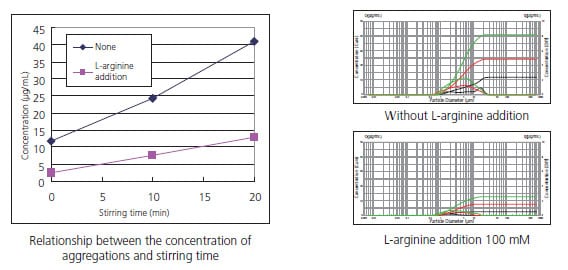Aggregates Sizer - Applications
Aggregation Analysis System for Biopharmaceuticals
The particle amount can be quantitatively evaluated in the 100 nm to 10 µm range
Changes in particle size distribution of gamma globulin by changing PH

This graph shows the measurement results of gamma globulin, which is dispersed by pure water, phthalate buffer solution (PH4) and phosphate buffer solution (PH7.4).
Concentration conditions are 1 mg/mL. The size of aggregation is mainly distributed from 1 μm to 10 μm. In the case of pure water, the concentration of SVP is about 4.4 μg/mL, the largest value. In the case of phosphate buffer solution, the concentration is about 0.4 μg/mL, the least value. This ratio is more than 10 times.

Time series changes of aggregations can be confirmed quantitatively
Continuous measurements with a minimum interval of 30 seconds
With the high-speed measurement function, a feature of the Aggregates Sizer, changes in aggregates (size or amount) can be quantitatively confirmed at a minimum interval of 30 seconds. As a result, not only the status before and after the change, but also the process as it happens can be observed, enabling evaluation of the speed of the change. Conversely, continuous measurements can be used to evaluate the absence of change, confirming that a sample is stable.
POINT
- A single laser light source system has been adopted, enabling high-speed measurements with a minimum interval of 30 seconds.
Time series changes in protein aggregations can be evaluated. - Using a batch cell, biopharmaceuticals can be measured while they are stirred. The aggregation of biopharmaceuticals has been reported to increase due to stirring. Accordingly, the system can also be used for properties evaluation screening with respect to the aggregation of biopharmaceuticals.
Accelerated test of aggregations by mechanical stimulus
Several days aggregation analysis can be reduced easily and dramatically
Changes in samples caused by mechanical stimulus using the batch cell’s stirring function can be observed. This system enables accelerated test without additional equipment and software, and this process can be used for the screening of proteins to confirm the properties of aggregations.
Inhibition effect to prevent aggregations by the L-arginine addition

This measurement confirms that aggregation of BSA solution (Tris buffer PH5) can be inhibited by adding L-arginine. The batch cell’s stirring function can accelerate the aggregation and reduce the total observation time of this kind of experiment.
This graph shows the relationship between the concentration of aggregations and stirring time. This result shows that the addition of L-arginine can reduce aggregations.
Accelerated testing of aggregations by mechanical stimulus

This graph shows the time series changes in particle size distribution and amount when gamma globulin is dispersed by a phosphorus acid buffer solution (PH 7.4), and is stirred in an Aggregates Sizer batch cell using the stirrer mechanism provided as standard.
The concentration of aggregate particles was approximately 0.4 µg/mL when unstirred (0 min). However, stirring for 30 minutes resulted in more than a five-fold increase to approximately 2.2 µg/mL.




